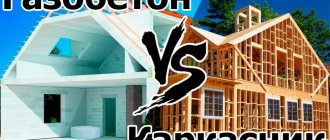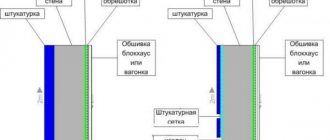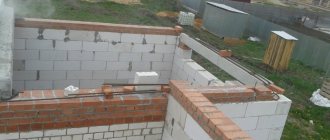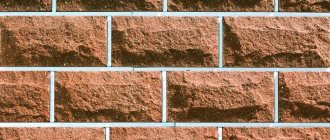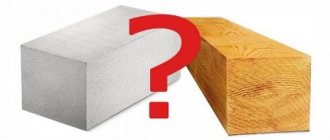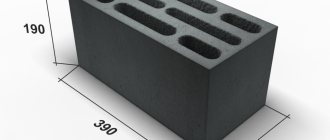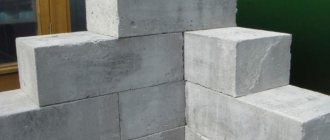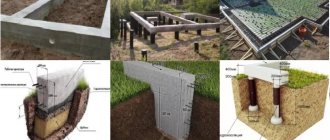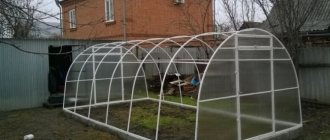When deciding whether aerated concrete or brick is better for building a house, you must first decide what is meant by the materials in question.
Aerated concrete in construction is a block of cellular structure made from a mixture of sand, cement, water and special gas-forming additives, due to which bubbles appear in the concrete (reducing the thermal conductivity and density of the material).
Brick is a material that has long been used in construction, which is produced from various clay mixtures during the firing process. Both materials are actively used in the construction of individual and industrial buildings and provide certain properties.
The main parameters by which brick and aerated concrete are compared are weight, compressive strength, resistance to high and low temperatures, cost, moisture absorption and vapor permeability, speed and ease of installation, performance characteristics of the finished building.
Brick characteristics
Before deciding whether to build a house from aerated concrete or brick, you need to carefully consider the properties of each material, and then compare them and select the one that is most suitable for the construction of a particular building.
Brick is high-quality, reliable and durable, environmentally friendly, and has a long service life. A properly constructed brick building will last at least a century. Typically, reinforced concrete slabs are installed for the flooring of such houses, thanks to which it is possible to build multi-storey buildings and premises of considerable area from brick.
Today you can find ceramic and sand-lime bricks on the construction market. Ceramic is made from clay, which is fired at high temperatures, giving the material resistance to various influences and strength. Ceramic bricks can be faced or ordinary.
Sand-lime brick is made from lime, sand and water in industrial molds. The containers are filled with the mixture, then the mixture is fired in an autoclave under high pressure. The brick turns out to be dense, durable, capable of not changing its properties under increased humidity and temperature changes.
Which is cheaper?
It will cost less money to build a home from porous aerated blocks for several reasons:
- The price of 1 m3 of aerated concrete is 2 times less than the cost of the same amount of brick;
- Light load-bearing walls do not need a powerful foundation and a durable base;
- The cost of transporting material is reduced;
- The walls are built quickly, so workers will require less money.
You need to add the cost of thermal insulation of a brick wall to the expense item. The cost of constructing a building from aerated concrete blocks will increase due to the need to install stiffening belts along the floors and above the foundation.
Characteristics of aerated concrete
Consideration of the properties of aerated concrete should begin with the list of ingredients included in the composition. Aerated concrete today is becoming increasingly popular due to its excellent performance characteristics, ideal block geometry, speed and ease of installation. Aerated blocks are produced from quartz sand, quicklime, cement, aluminum powder and water.
All ingredients are mixed in certain proportions, filled with water, then the mass is poured into containers where the reaction between aluminum and water takes place. Bubbles appear in the thickness of the concrete, the mixture increases in volume and hardens. Then the blanks are cut into blocks of the required size and sent to an autoclave to gain strength.
Thanks to its porous structure, aerated concrete demonstrates excellent thermal insulation qualities, is lightweight, and provides good sound insulation performance. The material breathes, is environmentally friendly (although the inclusion of aluminum powder in the composition raises questions), and allows you to quickly build durable buildings.
Comparison of products for home construction
The qualitative characteristics of materials compared to brick are indicated in GOSTs and SNiPs, which fully describe it, establish rules for installation, calculations for structural walls, and also provide references to other regulatory documents.
What the materials described (foam blocks, gas blocks, bricks) have in common is that they all belong to artificially created stones, the composition of which is mixed in molds .
But the brick is fired in industrial kilns at high temperatures, and foam blocks and gas blocks, after they are compacted and poured into molds, are left to dry in a specially adapted room at room temperature. Also, compositions for foam blocks can additionally be processed by autoclaving.
The substances that make up building stones are obtained naturally , and, therefore, are environmentally friendly and safe for human health. In addition, the surface of all products is not prone to the formation of mold and fungi on the surface of the wall structure. But the materials themselves require a strong foundation and carefully completed groundwork.
Each of the listed products when laying requires mandatory reinforcement (every 3-4 layers), the elimination of cold bridges, and the creation of standards for the thickness of the wall pie, which for the southern regions is at least 25 (cm), for the central regions - 40 (cm), northern – 60 (cm).
Despite the fact that materials differ in construction speed (brick - 1-2 months, foam blocks and gas blocks - 2-3 months), with a ready foundation, they all have good thermal insulation qualities and are considered durable and strong .
Both bricks and foam blocks with gas blocks will definitely need insulation and finishing from the inside. The outside of the brick is rarely finished, only if the owner of the building himself wants to change the siding design. Brick looks aesthetically attractive. Aerated blocks are more suitable for forming an internal thermal insulation layer, which can be installed behind internal walls made of any material, including brick, as well as for partition walls.
Recently, the production of aerated blocks has been improved, and products have already appeared on the market that can be used for main (load-bearing) walls. They are made from strong grades of cement, additives and more concentrated aluminum oxide (or other foaming agent).
Foam blocks are considered stronger than gas blocks, since the pores of the latter are wider and are very susceptible to ambient humidity. Therefore, any porous materials from which walls are built must be waterproofed on both sides, plastered and finished.
The main regulatory documents characterizing artificial building stones are:
- brick - GOST 530-2012;
- foam block - GOST 21520-89;
- gas block - GOST 31360-2007.
Advantages and disadvantages
When deciding whether to use aerated concrete blocks or brick (which is better for your home), you should consider the main pros and cons of both materials.
The main advantages of brick:
- Environmental friendliness
- Excellent soundproofing and thermal insulation characteristics
- Low temperature resistance
- Long service life
- Durability and reliability
Among the disadvantages, it is worth highlighting considerable weight and small size, which significantly increases construction time and high cost.
So, when considering which is cheaper (brick or aerated concrete), there is no need to perform complex calculations: definitely aerated concrete. Typically, sand-lime brick is not used for the construction of foundations, fireplaces, chimneys, wells, and stoves.
Advantages of aerated concrete:
- Relatively low cost
- Large size and light weight for easy installation
- Ecological cleanliness
- Good thermal and sound insulation properties
- Possibility of performing any finishing process
The disadvantages of aerated concrete include a high level of water absorption due to the pore structure, and therefore it is necessary to take care of the waterproofing layer. Aerated concrete is fragile, its load-bearing capacity is much lower than that of brick, so aerated blocks are usually chosen for the construction of low-rise buildings.
The thermal conductivity of aerated concrete is low, so the house will be warm.
Production and sizes
The first indicator by which we will compare is the size of the building elements and the material used to make them.
Brick
Ceramic bricks are made from natural clay by molding and firing. To make a silicate element, up to 90% quartz sand, 10% a mixture of lime and water are used.
Ceramics has high strength and frost resistance, especially if the product contains pores and voids. The characteristics are affected by the type of clay, firing time and temperature. Sand-lime brick is a popular material for the construction of residential buildings up to 5 floors; it is similar to ceramic in terms of performance, but is less presentable in appearance and does not particularly like moisture.
Aerated concrete block
To make aerated concrete blocks, quartz sand, cement, water, lime and aluminum powder are used. After mixing the components, aluminum, interacting with water and alkali, begins to release hydrogen, which forms pores in the body of the block.
The difference between brick and aerated concrete
Comparing aerated concrete and brick is a difficult task, since the materials differ in some properties, are identical in others, and are suitable for different types of construction in certain conditions. At a minimum, you need to consider the specific meanings of both options, and then choose in accordance with the project, requirements, and wishes.
Compressive strength index
This parameter demonstrates the strength of the future building and the level of maximum loads that the material can handle. Brick can withstand 110-220 kg/cm, aerated concrete - 25-50 kg/cm.
Aerated blocks are not suitable for the construction of load-bearing walls of multi-story buildings, but any houses can be built from brick. A strength table for each material can give more accurate figures.
Mechanical stability of the material
Aerated blocks are distinguished by their excellent geometry and large size - they can be built quickly, the walls will be perfectly smooth, the masonry will have small seams.
Aerated concrete walls have minimal thermal conductivity. But they require mandatory reinforcement due to the fragility of the material; the entire building requires the creation of an armored belt.
The mechanical stability of brick is definitely higher. Therefore, aerated blocks are much easier to process, but it is difficult to attach anything to them.
Brick is not so pliable, but it is dense and durable; you can attach household appliances, any brackets, shelves, cabinets, etc. to it. For aerated concrete, you will have to think about additional fixation and there will still be a risk of destruction of the material.
Weight of a cubic meter of masonry
The weight of one cubic meter of masonry makes it possible to calculate the total weight of the finished building, which is the main parameter when designing the foundation. Brick and aerated concrete differ very much in this parameter. Brick walls weigh much more than aerated concrete masonry, so you need to think about a more massive foundation for brick.
A cubic meter of brickwork exerts a force in the range of 1.2-2 tons, aerated concrete - 0.2-0.9 tons. With similar dimensions, a brick building will weigh 5-6 times more.
Ability to conduct heat
The thermal conductivity of brick and aerated concrete is also different. To achieve the optimal level of thermal insulation characteristics, it is necessary to make brickwork with a thickness of at least 50 centimeters. A similar effect can be achieved with aerated concrete masonry 40 centimeters thick. More accurate thermal conductivity indicators can be viewed in the comparative table (for aerated concrete and brick).
Resistance to low temperatures
This parameter determines the ability of the material to maintain its original properties after repeated freezing/thawing cycles, as well as when exposed to moisture. Brick is much more resistant to low temperatures - it survives more cycles and demonstrates better performance under different influences. To protect aerated concrete, an additional insulating layer will have to be installed.
For comparison: brick experiences about 50 freezing/thawing cycles, aerated concrete – a maximum of 25-30 cycles.
Moisture absorption
Moisture absorption is the ability of a material to accumulate moisture in its structure and retain it, then collapse under influence and deteriorate its properties. If water is absorbed in large quantities and does not dry out, microorganisms (fungus, mold) may appear in the house, an unpleasant odor may appear, and the microclimate may worsen.
Here the winner is definitely brick: aerated concrete shows a water absorption rate of 100%, brick – only 6-14%. The properties of concrete can be improved by laying a layer of waterproofing, protecting it from water outside and inside.
Fire resistance
The level of resistance to combustion of both materials is the same and corresponds to class A. Both brick and aerated concrete do not burn, do not emit toxins during the heating process, and are completely environmentally friendly. A house made of brick or aerated concrete can easily withstand direct flame for 2-2.5 hours.
Environmental friendliness of the material
Both aerated concrete and brick are environmentally friendly and completely safe for human health, provide an optimal microclimate in the building, and allow air to pass through. Porous concrete and clay bricks do not allow air and steam to stagnate in the house, are permeable, and do not evaporate any harmful compounds or toxins into the atmosphere.
Shrinkage
It is imperative to remember when building a house made of brick or aerated concrete that it is better to foresee everything in advance than to experience inconvenience or repair the finished building later. Shrinkage is a very important parameter in this context. Brickwork is practically not subject to shrinkage and exhibits similar parameters over many years of operation.
But aerated concrete masonry assumes a shrinkage of 0.3 millimeters per meter of height, which is noticeable. The material shrinks in the first two years after construction, and if this is not taken into account in the design and installation, cracks may appear, especially in warm and dry places.
Material cost
The cost of bricks and gas blocks differs significantly. But here you need to take into account the price not only of the material itself, but also the final estimate for building the house. After all, for both materials the masonry technology will be different. So, in Moscow and the region the price of a cubic meter of brickwork will cost about 80 USD, aerated concrete - from 45 USD. That is, it’s just that a box made from aerated concrete is cheaper.
But it is worth considering the nuances. Aerated blocks must be lined and protected from water with waterproofing. Masonry made of aerated blocks requires reinforcement, so the final calculations also need to include the price of a certain number of steel rods and binding wire.
Options for using and combining brick and aerated block during construction
If you want your future building to be able to combine the high strength of brick and the excellent thermal conductivity of the block, you should consider combining these two materials.
Cladding aerated concrete walls with bricks
Most often, load-bearing walls and partitions are erected using aerated concrete, and cladding is made using ceramic bricks. This combination is almost ideal for both products.
Cladding is done in one of the following ways:
- The brick is laid close to the aerated concrete wall. In this case, it will be important to think in advance about the option of sealing the walls from the inside. Suitable: plastering with cement-based mortar, laying tiles, wall cladding with preliminary laying of vapor barrier.
If the above conditions are not met, negative consequences cannot be avoided. The fact is that the heat accumulated inside the building, in the absence of a sealed interior, will tend to escape outside. And since there is no way out, moisture will accumulate on the outside of the aerated concrete wall, thereby destroying it. As a result, the operational and strength characteristics of the house will be compromised.
- Ceramic bricks are laid with a gap in relation to the aerated concrete wall, and there is no ventilation. The disadvantage of this method is obvious: condensation formed between the layer of brick and block due to the lack of ventilation will accumulate, flow down and have a destructive effect on the materials. The advantage of this method is the increase in thermal insulation properties.
Accordingly, again, this method is more suitable for an unheated building.
- The most reliable way is to line aerated concrete walls with bricks with a ventilated layer. The brick is attached to the aerated concrete at a distance of approximately 3-4 cm. If insulation is desired, the thickness of the material used must also be taken into account.
The ventilation option can be implemented in several ways.
In the first case, holes are made in a brick wall with the calculation of 30-35 cm2 of holes for every 10 square meters of wall. It is best to do them in seams. The lower ventilation ducts are designed with an inclination in order to better allow condensation to escape outside.
The second option is to use ventilation boxes. They are installed in vertical joints between neighboring bricks instead of mortar. Air circulation occurs through them. The condensation, in turn, comes out through holes made at the bottom of the wall.
With any of the options, it is possible to insulate the wall. It is worth choosing among materials that have the ability to allow air to pass through and resist the accumulation of moisture. This is, for example, basalt wool.
Insulation of aerated concrete followed by brick cladding
The purpose of insulation is very clear: to improve heat retention characteristics.
It is best to use the following materials:
- Expanded clay. This material is bulk and consists of fired clay granules.
What is better: aerated concrete or expanded clay?
- Basalt wool. The material is moisture resistant and has the ability to allow air to pass through.
Basalt wool
Basalt wool is mounted on an aerated concrete wall before facing. For this purpose, umbrella dowels are used. A hole is made in the wall and a plastic part is inserted, having previously shortened it for better fixation. Next, screw the nail directly through the insulation.
Diagram of one of the options for insulating aerated concrete
Expanded clay is poured during cladding as the masonry grows. When insulating a wall from the outside, using, in this case, foam plastic or extruded polystyrene foam is not advisable. These materials are more suitable for installation from inside the building, since they do not allow air to pass through at all.
Description of the process of attaching bricks to an aerated concrete wall
Facing bricks are attached to aerated concrete using several methods:
- Even during the construction of an aerated concrete wall, rods made of galvanized steel or stainless steel are fixed into the masonry. The diameter should be about 6 mm, the protrusion should be at least 10-12 cm. At the same time, the thickness of the future installed insulation should also be taken into account.
These rods will be fixed in the seams of the brickwork, thereby creating the integrity of the cladding and the aerated concrete wall.
- The most popular method is the method in which anchors are attached to a ready-made block wall during the construction of the cladding. In this case, the binding of aerated concrete and brick is more accurate.
Mounting methods, mini-instructions
Ventilation space when facing aerated concrete with bricks
Builders recommend
It is very difficult to understand which is better – a house made of brick or aerated concrete blocks. You need to look at additional parameters, operating conditions, requirements for the building itself, etc. Gas blocks are more permeable and retain heat better, but are very afraid of water and frost. And the brick demonstrates much higher compressive strength. Therefore, a brick house will last many times longer than an aerated concrete one.
But if a building made of aerated blocks is reliably protected from destructive factors and optimal operating conditions are ensured, it will also serve for a long time. And whether it makes sense to spend money on expensive brickwork when building, for example, a bathhouse - it’s up to the builder to decide.
If we talk about the simplicity and speed of installation, then gas blocks are definitely more preferable - you can work with the material yourself, erecting a building quickly and efficiently (a garage, for example). But here it is worth remembering about reinforcement - it is not necessary for bricks; aerated blocks need to be strengthened with steel reinforcement in any case.
There is no clear solution or answer to the question of which is better – brick or aerated concrete blocks. Here a lot depends on the nuances and additional factors. The most important thing in this case is to calculate and decide everything in advance, create a good project and follow construction technology.
Calculation of the cost of mortar for bricks
| Name | Values and cost UAH. | Cost rubles |
| Composition of the solution | 1 part cement and 3 parts sand. | |
| Cubic meter of solution | 250 kg of cement + 750 kg of sand. | |
| Price of cement for a cube of mortar | 10 bags of cement, 25 kg each = 550 UAH. | |
| Price of sand for a cube of mortar | 750 kg = 100 UAH. | 250 rub. |
| Total cost of a cube of solution | 650 UAH | 1700 rub. |
| Volume of mortar for laying a brick cube | 0.25m3. | |
| Cost of mortar per cubic meter of masonry | 650*0.25=140 UAH. | 400 rub. |
Calculations of the cost of work and materials for aerated concrete
| Name | Values or cost UAH. | Cost rubles |
| Aerated concrete size 600*250*200 | 33 pcs. cubed | |
| Aerated concrete size 600*250*300 | 22 pcs. cubed | |
| Aerated concrete size 600*250*400 | 16 pcs. cubed | |
| Cube of aerated concrete (m3) | 1300 UAH | 3900 rub. |
| Cost of laying aerated concrete per cubic meter | 300 UAH | 900 rub. |
The cost of laying a square meter of aerated concrete excluding work and glue
| Name | Values or cost (hryvnia) | Cost (rubles) |
| Square of aerated concrete masonry (200 mm) | 6.6 pcs. = 260 UAH. | 780 rub. |
| Square of aerated concrete masonry (300 mm) | 6.6 pcs. = 390 UAH. | 1170 rub. |
| Square of aerated concrete masonry (400 mm) | 6.6 pcs. = 520 UAH. | 1560 rub. |
Calculation of reinforcement and glue for reinforcing every third row of masonry
The cost of reinforcement and glue for reinforcing one linear meter is 20 UAH. (60 rubles).- One floor requires three reinforced rows.
- That is, for a linear meter of wall you need 60 UAH. (180 RUR). on the fittings.
- Thus, the average cost of each square of masonry will increase by 20 UAH. (60 rubles).
Cost of walls (80 m2) made of aerated concrete and brick
| Name | Cost (hryvnia) | Rubles |
| Aerated concrete 200 mm | 37,000 UAH. | 111 000 |
| Aerated concrete 300 mm | 55,000 UAH. | 165 000 |
| Aerated concrete 400 mm | 72,000 UAH. | 216 000 |
| Brick (one and a half bricks) | 72,000 UAH. | 216 000 |
| Brick (two bricks) | 92,000 UAH. | 276 000 |
Summarizing
In many cases, builders act out of habit, since for a long time it was believed that only a brick house can be strong and reliable, so new materials are not perceived very well.
But you shouldn’t ignore modern technologies, because by using them, you can not only build a house cheaper and faster, but also make it warmer, soundproof, which will add comfort to it.
You should not blindly follow the recommendations; you need to weigh all the advantages and disadvantages of the materials, decide on the characteristics that the building should have, and only after that make an informed choice of building materials. In some cases, the optimal solution will be to combine these materials to maximize their benefits.
Source
Calculation of adhesive for aerated concrete masonry
| Name | Values or cost (hryvnia) | Cost (rubles) |
| The amount of glue for laying a cube of aerated concrete | 38 kg. (one and a half bags of glue) | |
| Cost of a bag of glue (25 kg) for aerated concrete | 100 UAH | 300 rub. |
| Glue price | 4 UAH/kg. | 12 r/kg. |
| Cost of glue per cube of aerated concrete (1.5 bags) | 150 UAH | 450 rub. |
